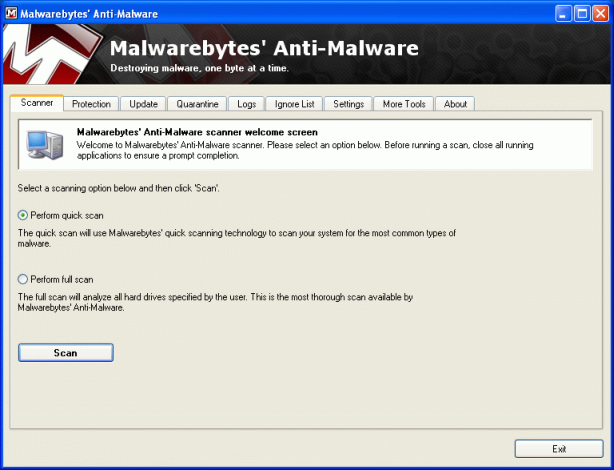Malwarebytes Anti-Malware 1.46 Helps You Clean Up

The installation of security software programs on test systems that are infected with malware can be difficult: sometimes the software won’t scan, sometimes it won’t run, and occasionally it won’t install at all. When vendors’ tech support are approached Recue CDs are sometimes provided as a potential solution, but occasionally it is recommended that consumers make use of a free third party program to clean the system up to the point where the security software can be installed to finish up the job, and when this is the case Malwarebytes Anti-Malware 1.46 is the program generally suggested.
There are a number of reasons this tool is advocated: it’s a smaller download, just 6MB, and it takes minutes to complete installation and update. This is a tonic when you compare it to the Spyware Doctor with AntiVirus 2010, retailing at $39.95, which requires a long update initially, which is then followed by another one after registration is completed.
There are no frills on Malwarebytes: there is not even a main status screen as there is generally. Instead, it opens up at its scanner page, ready to begin its work. The scanner is quick, too, with the company recommending Quick Scan, but running the Full Scan took only 12 minutes on a fresh, clean test system, about half the time a full scan took on the previous clean test system. Norton AntiVirus 2010, retailing at $39.95, took half an hour to scan the new test system, although, to be fair, the second scan was completed in less than 3 minutes.
Both Norton Antivirus and Spyware Doctor, previous and current Editor’s Choice products, respectively, were run through the new testing regime. As is generally the case, some of the samples defended themselves: the installer belonging to Norton addressed the majority of these, and a complete scan using the Norton Bootable Recovery Tool cleared one mischief maker.
Malware on 3 of the 13 test systems stepped in with Spyware Doctor. One was fixed by scanning with PC Tools Alternate OS Scanner, a product from rescue CD, and another was cured by installing it again after running a batch file PC Tools supplied. The gurus at tech support have yet to solve the third issue, so the dangers on that system do not figure in the score for Spyware Doctor.
As far as Malwarebytes goes, installation was free of any trouble on each of the 13 systems. When updating on 1 system became an issue, it was solved by downloading the update files manually, all making for an excellent start.
Unfortunately, test results from independent test labs were not available for Malwarebytes, since it hasn’t gone through any, but this is in keeping with its subdued style.
During this testing, 80 percent of malware samples were detected by Malwarebytes; 86 by Norton; and 88 by Spyware Doctor. Despite the fact that Malwarebytes discovered less threats than the other 2, it still attained a score of 7.3 out of 10 for malware removal, with the others managing only 7.1. Malwarebytes did a better job of clearing the dangers it detected.
Although Malwarebytes does try to get rid of keyloggers, this is not the application’s priority. In a second test that made use of commercial keyloggers, it only detected 29 percent of the samples, a poor showing when compare to the 86 percent Norton found, and the 92 percent discovered by Spyware Doctor. This resulted in Malwarebytes scoring a low 2.9 out of 10; Norton a higher 6.6.; and Spyware leading the pack with 7.
As previously mentioned, IT technicians frequently recommend Malwarebytes when harmful malware stops your other products from working properly. The worst threats often make use of rootkit technology, so it was assumed that this would be a priority, but this was not so. Malwarebytes neglected almost half of the rootkit samples on the system, and those that it did detect it left running. The scores for this test were 4 out of 10 for Malwarebytes; 7.7 for Norton; and Spyware Doctor the best with its 9 points.
Scareware is yet another kind of modern irritation that is difficult to remove: these are very insistent rogue security programs pretending that they can fix your problems as soon as you pay. Here Malwarebytes stepped up to the plate with a scareware removal score of 8.1; while Norton lagged with 7.1; and Spyware Doctor bringing up the rear for a change with just 6.9.
Malwarebytes is free software that can assist you when you run into obstacles with other products; it is quick to install and even quicker to run, and, although feeble in its dealings with rootkits and keyloggers, it remains quite effectual overall.
